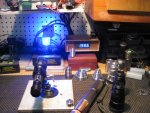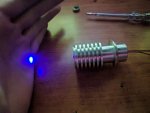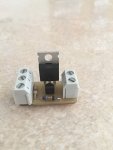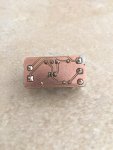Hello there!
My name is Ivo, and this will be my first laser.
I'm an electronics hobbyist, so I'm not new to electronics but my knowledge about lasers is only theoretical...
I've been reading, planning and designing for a long time. But now I have some parts and I was ready to make my first laser... but I think it died.
So first I tested the aixiz copper modules with a DVD red laser diode, because I wanted to try pressing this diode first so I don't screw it up with the M140-M. Something like training... The results were very nice at 170mA (very safe current), so I went up to 270mA with no problem and almost no heat.
I'm using a homemade constant current driver based on a N channel MOSFET and a NPN transistor.
But when I decided to go for the M140... I noticed something was wrong. At 270mA with the same driver the beam was weak. But when I increased the current to 330mA, the same brightness. At 600mA, the same... and at 1.3A the same weak beam, but everytime with more heat. The voltage drop of the diode is 4.96V (isn't that a little bit high?). See pictures:

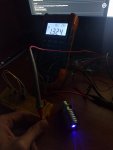
Oh, by the way... the small driver wasn't powerful enough so I built the circuit on a protoboard an I used a 12V LED PSU as power.
Mi guess is that the diode is died because of ESD or a peak... But I really hope I'm wrong...
Anyway... At least he red one is nice. XD
Thank you!
My name is Ivo, and this will be my first laser.
I'm an electronics hobbyist, so I'm not new to electronics but my knowledge about lasers is only theoretical...
I've been reading, planning and designing for a long time. But now I have some parts and I was ready to make my first laser... but I think it died.
So first I tested the aixiz copper modules with a DVD red laser diode, because I wanted to try pressing this diode first so I don't screw it up with the M140-M. Something like training... The results were very nice at 170mA (very safe current), so I went up to 270mA with no problem and almost no heat.
I'm using a homemade constant current driver based on a N channel MOSFET and a NPN transistor.
But when I decided to go for the M140... I noticed something was wrong. At 270mA with the same driver the beam was weak. But when I increased the current to 330mA, the same brightness. At 600mA, the same... and at 1.3A the same weak beam, but everytime with more heat. The voltage drop of the diode is 4.96V (isn't that a little bit high?). See pictures:


Oh, by the way... the small driver wasn't powerful enough so I built the circuit on a protoboard an I used a 12V LED PSU as power.
Mi guess is that the diode is died because of ESD or a peak... But I really hope I'm wrong...
Anyway... At least he red one is nice. XD
Thank you!





